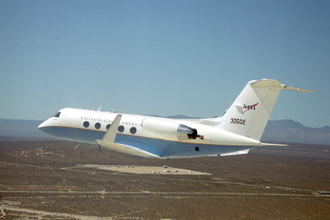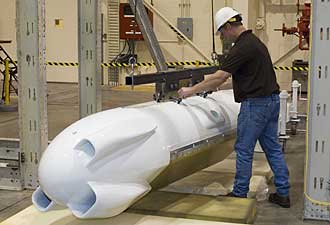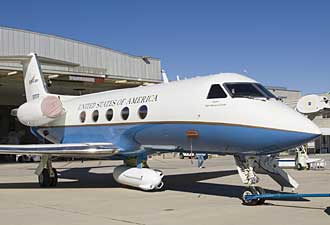- NASA Home
- | Centers
- | Dryden Home
- | Research
- | G-III
Search Dryden
Research
Gulfstream III Multi-Role Cooperative Research Platform
Project Summary
A Grumman Gulfstream III (G-III) business jet has been modified and instrumented by NASA's Dryden Flight Research Center to serve as a multi-role cooperative research platform testbed for a variety of flight research experiments. The twin-turbofan aircraft provides long-term capability for efficient testing of subsonic flight experiments for NASA, the U.S. Air Force, other government agencies, academia, and private industry. The aircraft, which carried the military designation of C-20A, was obtained from the U.S. Air Force in 2003. Image Above: Gulfstream III in flight over NASA Dryden Flight Research Center. NASA Dryden photo.
Image Above: Gulfstream III in flight over NASA Dryden Flight Research Center. NASA Dryden photo. NASA Dryden's G-III is equipped with a self-contained on-board Data Collection and Processing System (DCAPS). This embedded instrumentation system allows for automated configuration setups to reduce required engineering support for each mission. It includes primary and backup systems to assure mission reliability, with the backup system available for use concurrently as a slave system when needed. DCAPS is designed to allow easy upgrades, addition of add-on systems for expansion, and to operate in both autonomous and manual modes.
The custom DCAPS system installed on the G-III was developed to enable processing, distributing, displaying and archiving aircraft flight data and customers' experimental data in real time. In addition, it features a video collection and distribution system, satellite communications systems, including airborne Internet capability, satellite phones, an upgraded 120-amp electrical power system and an infrared-capable pilot's heads-up display. The telemetry system can receive and relay data in S, Ku and L-band frequencies.
Representative Projects and Experiments
A number of research projects and experiments have been proposed or flown using the advanced instrumentation capabilities installed on the Gulfstream III, among them:UAVSAR
The Unmanned Air Vehicle Synthetic Aperture Radar (UAVSAR) is an Earth Science Capabilities Demonstration project jointly supported by the Jet Propulsion Laboratory and NASA Dryden in which a synthetic aperture radar will be flown on the G-III in a specially designed pod that will be interoperable with unmanned aircraft in the future. The G-III provides a platform to not only test and evaluate the new radar, but can also be used to gather scientific data for geological studies on earthquake prediction. In order to support the installation of the UAVSAR pod, the GIII airframe has been structurally modified to incorporate a MAU-12 ejector rack on the bottom of the fuselage. This unique G-III modification will remain available for use by future projects. Image Above: NASA Dryden lead technician David Neufeld prepares JPL's unmanned aircraft Synthetic Aperture Radar pod for inertial swing tests in Dryden's loads laboratory. NASA Dryden photo by Tom Tschida.
Image Above: NASA Dryden lead technician David Neufeld prepares JPL's unmanned aircraft Synthetic Aperture Radar pod for inertial swing tests in Dryden's loads laboratory. NASA Dryden photo by Tom Tschida.
Access 5
Acting as an intruder aircraft, the G-III flew an experiment for the Access 5 program in September 2005 with Scaled Composites' Proteus aircraft, which served as a surrogate unmanned air vehicle (UAV). The G-III carried collision avoidance systems and flew a flight test matrix to analyze sense-and-avoid displays and reaction times for the UAV pilot, who was flying the Proteus remotely from a ground control station during the experiment.Collision Avoidance
Another flight experiment that has been proposed by a commercial aerospace company would employ NASA Dryden's G-III with other aircraft to investigate collision avoidance / clearance flight patterns. This experiment would be conducted no earlier than the summer of 2007. Image Above: An underbelly pod housing a Synthetic Aperture Radar designed for use on unmanned aircraft is prepared for flight tests on NASA's Gulfstream III research testbed. NASA Dryden photo by Tom Tschida.
Image Above: An underbelly pod housing a Synthetic Aperture Radar designed for use on unmanned aircraft is prepared for flight tests on NASA's Gulfstream III research testbed. NASA Dryden photo by Tom Tschida.
Aircraft Description
The Gulfstream III was built by Gulfstream Aerospace Corp. In its commercial versions, the G-III's basic role is that of an executive business aircraft that can carry up to 12 passengers. The C-20B version currently flown by the Air Force serves in a similar capacity for high-level government and military officials.The G-III's maximum takeoff weight with full fuel and passengers/cargo is 69,700 lbs. Empty, the unmodified airplane weighs about 38,000 lbs. The aircraft has a wingspan of just over 77 feet, is about 83 feet long and just over 24 feet tall. Normal cruise for the aircraft is 459 knots (527 mph), and its top speed is 576 mph (501 knots; Mach 0.85). Its maximum operating altitude is 45,000 feet. The Gulfstream-III has a range with a full load of passengers or equipment of about 3,400 nautical miles (4,000 statute miles).
The aircraft is powered by two Rolls-Royce Spey F113-RR-100 turbofan engines, each producing 11,400 pounds (5,170 kg) of thrust.
Related Sites
+ Past Research